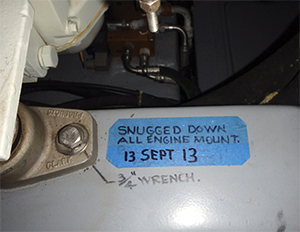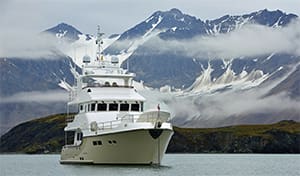One frequent question I hear from my trawler clients is, “What hand tools should I have on board?” Resisting the urge to reply, “Get two of everything you think you might need,” the best response is a well-thought-out set of hand tools that will enable you to effect repairs, complete servicing and get you back in operation. I don’t believe that you need a separate workshop where you have power tools that will allow you to machine replacement parts (although I’ve seen them on larger trawlers and they are spectacular). Owner/operators should focus on hand tools that they are comfortable using and I advise my clients to keep it simple — start with a basic inventory and then add what you require as needs arise.
I’ve been on hundreds of trawlers and spent time with the owners to review what tools they are using. For simplicity, this review will just focus on hand tools, not power tools. A standard tool kit package with screwdrivers, a socket set, ratchets, files, knives, chisels, hammers and assorted pliers and wrenches is a simple solution, but there are many specialty tools you need to also consider. The farther away from land that you travel, the more self-sufficient you need to be. Having the right tool for the job takes a bit of upfront research by studying what you need for every system. Too many onboard tool chests are filled with rarely used and rusty implements. It’s better to keep things clean and orderly and employ the essentials that will see regular use.
 |
|
An onboard tool chest is a great way to store tools. |
You can’t be expected to be an expert boatbuilder who can repair everything, but you should be familiar enough and prepared for rudimentary troubleshooting to keep items functioning. An “inventory and anticipate” approach will help make sure that, for example, you have wrenches to adjust your stuffing box and a crowbar or jumbo screwdriver for adjusting the alternator swing when tightening belts.
We live in a throwaway society; if my toaster doesn’t work, I buy a new one. Pulling a toaster apart to restore it is only reserved for the rare tinkerers who have desire, aptitude and, more importantly, the time. For cruisers, the important aspect is to be able to get things back into working order, maybe not a full-blown repair. You don’t necessarily need to be mechanically inclined or have grown up fixing cars to go out cruising, but it sure helps. You should strive for the ability to make a fix that will allow you to safely return to the dock. Things happen, and even temporary remedies can help save the day. There is a great deal of satisfaction in diagnosing and then solving a problem on board. Eventually you can have a qualified technician replace a part or reassemble a major breakdown, so don’t fret about components you don’t comprehend. You will likely be just fine if you can service the basic pieces of equipment that falter.
 |
|
A soft tool bag for easily carrying tools to where the work is. |
Most temperamental systems
The potentially temperamental systems that seem to cause the most discomfort and headaches for cruisers are toilets, windlasses and stabilizers, along with anything electrical (fuses and breakers mostly). Many issues result from operator error — inverting a duckbill valve on a head, for example — but most arise from regular operational use and normal wear and tear. The reality is that anything that can break down will break down, and you need to be ready to handle a makeshift repair that will enable you to finish your trip.
An entire volume* could be dedicated to all of the tools you can take, but this article is intended to help identify some of the more popular but less commonly carried hand tools for offshore cruisers to consider in order to be prepared to keep your trawlers dialed-in. (*Note, a recommended trawler tool list is available by request at the end of this article).
 |
|
Engine mounts snugged down and labeled with date and tool size. |
Large tool chests with built-in drawers are nice if you have room, but soft carrying case bags are often more practical for mobile work and won’t scratch surfaces.
I divide trawler tools in three different categories: diagnostic, routine service and build/repair. There is a limit to how much room you can absorb to store your tools, but you need to give some serious thought to the potential situations that will occur, especially if a specialty tool will be required. When you are out at sea or in an isolated anchorage, it is essential to have what you need already on board.
Here are some basic recommendations to get you thinking about what you might want to keep aboard as defined by the above categories:
 |
|
The size of the Allen wrench and its location is noted with permanent marker. |
Diagnostic tools
• Digital multi-meter — essential for diagnosing electrical issues.
• AC/DC voltage detector (the size of a large pen for confirming power).
• Small mirror on an extension to see the other side of the engine or deep in the bilge.
• Infrared temperature gun — digital read-out thermometer.
• Borescope, an “eye” on the end of a tube for hard-to-see inspections (a bit extreme but not uncommon on larger yachts with sophisticated systems to inspect difficult areas to see).
• Routine service tools.
• Impeller puller specific to the impeller(s) on your engine(s) and generator(s).
• Strap wrench for filters.
• Spring tool nut driver (long flexible spring) to adjust hose clamps in hard-to-reach places.
 |
|
An underwater scraping kit with a scraping tool. |
• Drain auger — a “plumber’s snake” for clearing hose clogs.
• Crowbar, pry bar and/or extra-long screwdriver for alternator adjusting when changing belts.
• Grease gun for windlass — you should squeeze some grease in your windlass’ Zerk fitting annually.
• Wire brush for knocking off corrosion (battery terminals) and preparing bubbling paint for recoating.
• Stuffing box wrench set — an open and closed wrench that can be worked in tandem and sized for the double nuts you need to adjust.
• Bent tip awl — these have a bend or hook at the tip with a sharp point and can be used to pull hoses off fittings (think industrial dental pick) and to remove flax packing.
• Slip-joint pliers.
• A multi-tool, such as a Leatherman or a Gerber.
 |
|
Suction cup handle for holding position underwater. |
Build/repair tools
• Safety goggles.
• Hammers — all types.
• Soft pound mallet.
• Saws, including a wood saw and hacksaw.
• Vise, either permanent or temporary mount.
• C-clamps.
• Duct tape.
• Seizing wire.
• Wire crimpers and strippers.
• Tin snips (metal cutting shears).
 |
|
A Pik Stik bilge grabber tool. |
Specialty tools
I’m going to add one last category — specialty tools that might be surprisingly useful but often aren’t on board. This list includes some common household items that you may find helpful and want to add to your trawler tool arsenal.
• A wire coat hanger, which can be fashioned to grab something out of the bilge or ream a hose that has collected impeller parts.
• Pipe cleaners — the white pipe smoker’s cleaners are great for wrapping around fittings where you have fixed a leak, and will wick liquid to provide a “telltale” if the leak comes back.
• PVC tube “persuader” — cutting a 1-inch-diameter PVC pipe into some short lengths (6 to 12 inch) that can fit over a through-hull valve handle will help you reach and flex hard-to-reach outboard valves and can help keep handles exercised so they don’t freeze up.
• Jerry jug or empty plastic peanut butter jar with a screw-top lid so you can collect and store water in fuel samples until you can dispose of the contents properly.
• Turkey baster — a giant “eye dropper” for lowering the diesel level in a Racor when changing elements.
• Jar lid gripper pad — a soft rubber disc that provides non-slip gripping is great for working on coolant reservoir caps.
• Suction cup handle for support in an awkward reach, or for hanging onto the boat if you must go in the water with a mask to work on something.
• Bilge grab tool — a “long arm” with a trigger handle and clamping end used to reach jars on the top shelf at home can also retrieve dropped items in the bilge. An extension (like a telescoping antenna) with a magnet on the end may help you reclaim a dropped fastener.
• Parachute/messenger cord for lashing, securing or pulling wires/lines.
• Bucket, sponge, funnel, Ziploc bags, rags — there are many ways to create a mess when changing fluids, usually the second time you have a better approach for a tidy transition.
 |
|
It’s a great idea to have some tools ready to go for serious work at short notice. |
The independence that cruising offers is one of the greatest appeals of the trawler lifestyle. Traveling offshore, away from civilization, and dropping the hook in a secluded cove provides a wonderful escape. This freedom is much easier to enjoy if you have prepared for the unexpected problems that will inevitably and eventually crop up. Boat parts, equipment and systems need to be looked after properly to ensure reliability. Trawlers flex and pitch, rattle and roll — you need to tighten fasteners, clamps, etc., that loosen due to natural movement. A consistent maintenance regime with detailed records of upgrades and service work is an important way to stay ahead of the game. Proactive care and addressing even seemingly minor hiccups in a timely manner can save you a lot of angst, especially if your attention prevents an annoyance from developing into a disaster.
Okay, all this is fine to get you started, but some people just want a prepared list of what others have already assembled. I’ve collaborated with one of my clients, Kevin Jeffries, to prepare a list for his Nordhavn 55, Red Rover. Kevin is a tool guy; he is a hands-on, Mr. Fix-It type who is quite capable. If you would like to receive a copy of the Red Rover tool list in Excel format (so you can modify yourself) please send an email with the subject line “Ocean Navigator Tool List request” to the author and I’ll send it over.
Jeff Merrill, CPYB, is the president of Jeff Merrill Yacht Sales, Inc.- www.JMYS.com. He is a veteran yacht broker who provides individual attention and professional representation to buyers and sellers of premium brand, oceangoing trawlers. Merrill is active in the cruising community as a public speaker and writer and enjoys spending time at sea with clients. Email Merrill at: Jeff.Merrill@JMYS.com.

